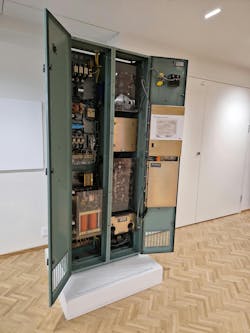ABB celebrates half a century of variable speed drives
October 2025 marks the 50th anniversary of the low-voltage variable speed drive (LV VSD), which was used in a commercial application for the first time at a sawmill in Finland, in 1975. It was developed in the 1970s by Strömberg, a predecessor to ABB.
The LV VSD addressed a long-standing limitation of the traditional squirrel-cage induction motor, which had remained fixed-speed since its invention by Nikola Tesla in 1888. Prior to the introduction of VSDs, adjusting motor performance for variable loads typically relied on mechanical throttling methods, such as dampers or valves.
“For 50 years, ABB’s low-voltage drives have been a part of many era-defining technologies and breakthroughs, from electric public transport to today’s push for energy-efficient, low-carbon industries,” explained Tuomo Hoysniemi, president of drive products at ABB (Figure 1).
“Before the VSD, getting a fixed-speed motor to deliver the right output was like driving your car with your foot all the way down on the accelerator and braking at the same time to control your speed,” said Hoysniemi. Commercially, this was an expensive problem, but, in terms of energy efficiency, it was even worse. “With a variable speed drive, you can be precise about output, dramatically improving industrial energy efficiency,” he explained. “Low-voltage VSDs were a major breakthrough. They have since become the gold standard and have seen wider and faster adoption, but, still to this day, less than 25% of industrial motors worldwide are connected with a drive.”
The first commercial LV VSDs were developed in the early 1970s by Strömberg, a Finnish electrical engineering company that would become part of ABB in the 1980s. In 1975, the company launched the Strömberg Asynchronous Motor Inverter (SAMI A), a low-voltage drive capable of precisely regulating the speed of an ac induction motor (Figure 2).
The first real-world installation of the SAMI A took place later that year at the Karihaara sawmill in northern Finland, using three 350 kVA/500 V units. This demonstrated that variable speed control could offer measurable efficiency and reliability benefits in an industrial environment. The technology quickly expanded into new sectors and applications, including Helsinki’s metro system, where it supported public transport.
Martti Harmoinen, who passed away in 2023, was the Strömberg engineer credited with leading the original development team (Figure 3). He received the Finnish Engineering Award in 1981 and the honorary title of professor in 1995.
“Not every motor on the planet can be fitted with a variable speed drive, but there is no question that most of them should be,” said Chris Poynter, president of Motion High Power at ABB. “There is a perception that sustainability is cost-prohibitive, but energy efficiency and decarbonization in an industrial setting are commercially prudent as well as fulfilling our duty to the planet. The total cost of ownership of running a motor with a VSD is far lower than working it to an early failure.”




